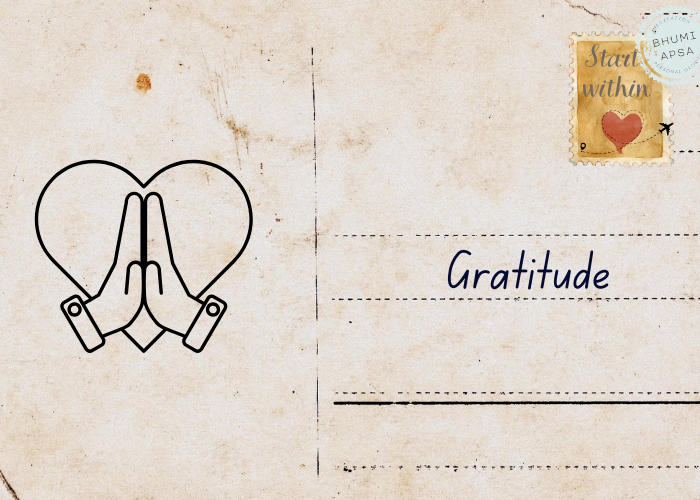The Five Dimensions of Gratitude and How to Cultivate Them

Gratitude is often seen as a personal experience—something we feel when good things come our way. But in reality, gratitude extends far beyond personal gain. It connects us to others, to nature, and even to the rhythm of life itself. Gratitude isn’t just an emotion; it’s a way of being, a lens through which we can view the world.
Everything in nature mirrors gratitude in its own way. A tree provides shade without asking for anything in return, and the rain nourishes the earth to sustain life. Recognizing this interconnectedness opens the door to experiencing gratitude as a boundless, transformative practice that enriches life at every level.
The Five Dimensions of Gratitude
1. Gratitude for When Others Give to Us
The most commonly recognized form of gratitude arises when someone does something kind for us—whether it’s a thoughtful gesture, a word of encouragement, or an act of generosity. This gratitude stems from acknowledging and appreciating the kindness of others. Taking the time to express thanks deepens our relationships and reminds us of the importance of human connection.
2. Gratitude for What We Have
This dimension is about appreciating the abundance already present in our lives. From the roof over our heads to the simple pleasures of a good meal or a kind conversation, this gratitude shifts our perspective from scarcity to sufficiency. When we pause to truly see and savor what we have, we anchor ourselves in the richness of the present moment.
3. Gratitude for What We Give
Gratitude isn’t just about receiving; it also arises from giving. Whether it’s lending a helping hand, sharing resources, or simply offering a listening ear, the act of giving creates a profound sense of fulfillment. True giving comes without the expectation of acknowledgment or reciprocity. When we notice disappointment in the absence of thanks, it’s an opportunity to grow in selflessness and reflect on our intentions.
4. Gratitude for Others’ Joy
Sometimes, gratitude takes the form of rejoicing in someone else’s happiness. Watching a loved one achieve their dream, seeing a stranger experience an unexpected kindness, or celebrating a community’s success reminds us of the beauty of shared joy. This dimension deepens our sense of connection and highlights the interwoven nature of our lives.
5. Gratitude Without a Cause
The most profound form of gratitude isn’t tied to any specific event or action—it’s simply a state of being. This quiet, all-encompassing awareness of life itself allows us to feel grateful without needing a reason. It’s about appreciating existence in its entirety, from the breath in our lungs to the vastness of the universe. This dimension can be cultivated through mindfulness and meditation, connecting us to the present moment with deep serenity.
How to Cultivate Gratitude
1. Gratitude Journaling
Set aside a few minutes each day to list three things you’re grateful for. These can be big or small: a meaningful conversation, the warmth of sunlight, or even a smile from a stranger. Over time, this practice trains your mind to focus on positivity and abundance, rewiring your brain to seek joy in the everyday.
2. Gratitude Through Action
Take your gratitude practice a step further by shifting the focus from receiving to giving. The true power of gratitude lies in the act itself—not in the recognition or thanks that may follow. Whether it’s helping a neighbor, volunteering for a cause, or offering a kind word to someone in need, immerse yourself fully in the joy of giving.
As you perform these acts, try to connect with the feeling of gratitude that comes from being able to contribute, no matter how small the gesture. Notice the fulfillment that arises when your actions align with a spirit of selflessness. If a “thank you” doesn’t follow, use it as an opportunity to reflect on your intentions and deepen your practice. True gratitude grows not from expecting acknowledgment, but from the quiet satisfaction of knowing you’ve made a positive impact.
3. Gratitude Meditation
Incorporate gratitude into your meditation practice. Begin by visualizing moments that resonate with each dimension of gratitude—what you have, what you’ve received, what you’ve given, the joy of others, and gratitude without cause. Allow yourself to fully experience these feelings, cultivating a deep, enduring connection to gratitude.
4. Find Gratitude in Nature
Nature offers endless reminders of balance and generosity. Spend time in a park, forest, or garden, observing the harmony of ecosystems. The unselfish way a tree provides shade or the way rivers sustain life can inspire us to embody the same spirit of giving and gratitude.
5. Pause and Reflect
Build moments of stillness into your day to reflect on gratitude. Pause during meals, before sleep, or while walking to consciously appreciate the present moment. These micro-practices anchor gratitude into your daily routine and foster mindfulness.
Embrace Gratitude as a Way of Life
Gratitude is more than a fleeting emotion—it’s a transformative practice that can shift your perspective, strengthen your relationships, and bring a profound sense of joy. By exploring and cultivating its many dimensions, you can unlock its full potential to enrich your life.
If you’re ready to deepen your gratitude practice and explore mindfulness, I invite you to join one of my meditation classes. Together, we can nurture gratitude as a way of life and help you tap into its boundless power.
